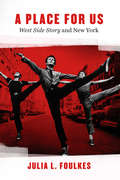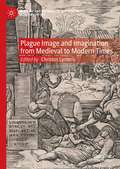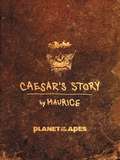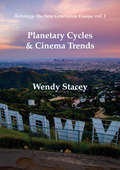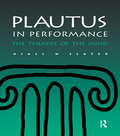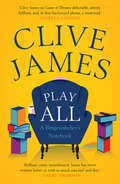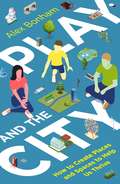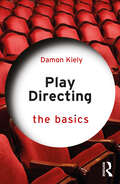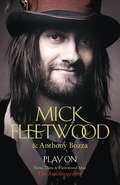- Table View
- List View
A Place for Us: “West Side Story” and New York
by Julia L. FoulkesFrom its Broadway debut to the Oscar-winning film to countless amateur productions, West Side Story is nothing less than an American touchstone—an updating of Shakespeare vividly realized in a rapidly changing postwar New York. That vision of postwar New York is at the heart of Julia L. Foulkes’s A Place for Us. A lifelong fan of the show, Foulkes became interested in its history when she made an unexpected discovery: scenes for the iconic film version were shot on the demolition site destined to become part of the Lincoln Center redevelopment area—a crowning jewel of postwar urban renewal. Foulkes interweaves the story of the creation of the musical and film with the remaking of the Upper West Side and the larger tale of New York’s postwar aspirations. Making unprecedented use of director and choreographer Jerome Robbins’s revelatory papers, she shows the crucial role played by the political commitments of Robbins and his fellow gay, Jewish collaborators, Leonard Bernstein and Arthur Laurents. Their determination to evoke life in New York as it was actually lived helped give West Side Story its unshakable sense of place even as it put forward a vision of a new, vigorous, determinedly multicultural American city. Beautifully written and full of surprises for even the most dedicated West Side Story fan, A Place for Us is a revelatory new exploration of an American classic.
A Place for Us: “West Side Story” and New York
by Julia L. FoulkesFrom its Broadway debut to the Oscar-winning film to countless amateur productions, West Side Story is nothing less than an American touchstone—an updating of Shakespeare vividly realized in a rapidly changing postwar New York. That vision of postwar New York is at the heart of Julia L. Foulkes’s A Place for Us. A lifelong fan of the show, Foulkes became interested in its history when she made an unexpected discovery: scenes for the iconic film version were shot on the demolition site destined to become part of the Lincoln Center redevelopment area—a crowning jewel of postwar urban renewal. Foulkes interweaves the story of the creation of the musical and film with the remaking of the Upper West Side and the larger tale of New York’s postwar aspirations. Making unprecedented use of director and choreographer Jerome Robbins’s revelatory papers, she shows the crucial role played by the political commitments of Robbins and his fellow gay, Jewish collaborators, Leonard Bernstein and Arthur Laurents. Their determination to evoke life in New York as it was actually lived helped give West Side Story its unshakable sense of place even as it put forward a vision of a new, vigorous, determinedly multicultural American city. Beautifully written and full of surprises for even the most dedicated West Side Story fan, A Place for Us is a revelatory new exploration of an American classic.
A Place for Us: “West Side Story” and New York
by Julia L. FoulkesFrom its Broadway debut to the Oscar-winning film to countless amateur productions, West Side Story is nothing less than an American touchstone—an updating of Shakespeare vividly realized in a rapidly changing postwar New York. That vision of postwar New York is at the heart of Julia L. Foulkes’s A Place for Us. A lifelong fan of the show, Foulkes became interested in its history when she made an unexpected discovery: scenes for the iconic film version were shot on the demolition site destined to become part of the Lincoln Center redevelopment area—a crowning jewel of postwar urban renewal. Foulkes interweaves the story of the creation of the musical and film with the remaking of the Upper West Side and the larger tale of New York’s postwar aspirations. Making unprecedented use of director and choreographer Jerome Robbins’s revelatory papers, she shows the crucial role played by the political commitments of Robbins and his fellow gay, Jewish collaborators, Leonard Bernstein and Arthur Laurents. Their determination to evoke life in New York as it was actually lived helped give West Side Story its unshakable sense of place even as it put forward a vision of a new, vigorous, determinedly multicultural American city. Beautifully written and full of surprises for even the most dedicated West Side Story fan, A Place for Us is a revelatory new exploration of an American classic.
A Place for Us: “West Side Story” and New York
by Julia L. FoulkesFrom its Broadway debut to the Oscar-winning film to countless amateur productions, West Side Story is nothing less than an American touchstone—an updating of Shakespeare vividly realized in a rapidly changing postwar New York. That vision of postwar New York is at the heart of Julia L. Foulkes’s A Place for Us. A lifelong fan of the show, Foulkes became interested in its history when she made an unexpected discovery: scenes for the iconic film version were shot on the demolition site destined to become part of the Lincoln Center redevelopment area—a crowning jewel of postwar urban renewal. Foulkes interweaves the story of the creation of the musical and film with the remaking of the Upper West Side and the larger tale of New York’s postwar aspirations. Making unprecedented use of director and choreographer Jerome Robbins’s revelatory papers, she shows the crucial role played by the political commitments of Robbins and his fellow gay, Jewish collaborators, Leonard Bernstein and Arthur Laurents. Their determination to evoke life in New York as it was actually lived helped give West Side Story its unshakable sense of place even as it put forward a vision of a new, vigorous, determinedly multicultural American city. Beautifully written and full of surprises for even the most dedicated West Side Story fan, A Place for Us is a revelatory new exploration of an American classic.
The Place of Breath in Cinema
by Davina QuinlivanHeadline: An exploration of the figuring of absence in film.PitchHow can the cinema articulate the interstices between visibility and invisibility, and how are such notions of absence and the unseen implicated in the film experience? This study considers the locus of the breathing body in the film experience and its implications for the study of embodiment in film and sensuous spectatorship. Quinlivan puts forward a mode of critical engagement with film shaped by the foregrounding of the human body in the filmic diegesis and the viewing experience. The book's foregrounding of the human body as an, importantly, breathing body in film, coupled with its fresh engagement with continental philosophy, Post-Structuralist Film Theory and Contemporary Western Cinema, makes a unique and valuable contribution to the field.Key features: * Case studies are taken from the work of major directors, including Cronenberg and von Trier* Key concepts explored are filmic space (air and the elemental in film), corporeality (bodies on screen and the film itself as a breathing body) and inter-subjectivity (community and sociality).* Makes a notable contribution to the study of film sound and haptic perception. Keywords: breathing, embodiment, phenomenology, immateriality, haptic visuality, spatiality, inter-subjectivity, breath, Luce Irigaray, David Cronenberg, Atom Egoyan, Lars von Trier, Breathing Body, trauma
The Place of Breath in Cinema
by Davina QuinlivanHow can the cinema articulate the interstices between visibility and invisibility, and how are such notions of absence and the unseen implicated in the film experience? This study considers the locus of the breathing body in the film experience and its implications for the study of embodiment in film and sensuous spectatorship. Quinlivan puts forward a mode of critical engagement with film shaped by the foregrounding of the human body in the filmic diegesis and the viewing experience. The book's foregrounding of the human body as an, importantly, breathing body in film, coupled with its fresh engagement with continental philosophy, Post-Structuralist Film Theory and Contemporary Western Cinema, makes a unique and valuable contribution to the field.
Placing Shadows: Lighting Techniques for Video Production
by Chuck Gloman Tom LeTourneauA mix of theory and practical applications, Placing Shadows covers the physical properties of light and the selection of proper instruments for the best possible effect. For the student, advanced amateur, and pros trying to enhance the look of their productions, this book examines the fundamentals and is also a solid reference for tips on better performance.
Placing Shadows: Lighting Techniques for Video Production
by Chuck Gloman Tom LeTourneauA mix of theory and practical applications, Placing Shadows covers the physical properties of light and the selection of proper instruments for the best possible effect. For the student, advanced amateur, and pros trying to enhance the look of their productions, this book examines the fundamentals and is also a solid reference for tips on better performance.
Plague Image and Imagination from Medieval to Modern Times (Medicine and Biomedical Sciences in Modern History)
by Christos LynterisThis edited collection brings together new research by world-leading historians and anthropologists to examine the interaction between images of plague in different temporal and spatial contexts, and the imagination of the disease from the Middle Ages to today. The chapters in this book illuminate to what extent the image of plague has not simply reflected, but also impacted the way in which the disease is experienced in different historical periods. The book asks what is the contribution of the entanglement between epidemic image and imagination to the persistence of plague as a category of human suffering across so many centuries, in spite of profound shifts in our medical understanding of the disease. What is it that makes plague such a visually charismatic subject? And why is the medical, religious and lay imagination of plague so consistently determined by the visual register? In answering these questions, this volume takes the study of plague images beyond its usual, art-historical framework, so as to examine them and their relation to the imagination of plague from medical, historical, visual anthropological, and postcolonial perspectives.
Planet of the Apes: Caesar's Story
by MauriceTo celebrate the 50th anniversary of the Planet of the Apes franchise: an illustrated life story of Caesar, the brave and extraordinary leader of the apes, as told by Maurice, Caesar's best friend. After the events of War for the Planet of the Apes, Caesar's tribe has finally found a safe refuge from the last remnants of the humans who wish to see them wiped out. It comes at a cost, however, as Caesar dies before he can see the apes thrive and prosper in their new home. Maurice, as a gift to Caesar's son Cornelius for when he grows older, decides to recount and chronicle Caesar's story so that his son can truly know what a unique and brave ape his father was, and inspire Cornelius in turn.Caesar's Story is this chronicle, and tells the story of Caesar from his earliest days under the care of scientist Will Rodman, as well his life with the ape colony in Muir Woods after the outbreak of the Simian Flu, his interactions with Malcolm and Ellie, the dangerous ape Koba, and his ultimate battle with and imprisonment by the vicious and unstable Colonel. The book also chronicles what happens in-between the events of Rise and Dawn of the Planet of the Apes, as well as the events between Dawn of and War for the Planet of the Apes. The book includes Maurice's personal thoughts and reflections of his long time spent alongside Caesar, and contributions from several other key apes that knew Caesar. The result is a truly one-of-a-kind celebration of the new Planet of the Apes trilogy and the franchise as a whole.
Planetary Cycles & Cinema Trends (Astrology the New Generation)
by Wendy StaceyPlanetary Cycles and Cinema Trends is Volume 1 in a series of astrological essays from some of astrology’s leading lights. In this essay, mundane astrologer Wendy Stacey considers some of the key moments in the development of cinema, and also analyses the horoscopes for the premieres of films such as Gone with the Wind and the Harry Potter series.
Plant Horror: Approaches to the Monstrous Vegetal in Fiction and Film
by Dawn Keetley Angela TengaThis collection explores artistic representations of vegetal life that imperil human life, voicing anxieties about our relationship to other life forms with which we share the earth. From medieval manuscript illustrations to modern works of science fiction and horror, plants that manifest monstrous agency defy human control, challenge anthropocentric perception, and exact a violent vengeance for our blind and exploitative practices. Plant Horror explores how depictions of monster plants reveal concerns about the viability of our prevailing belief systems and dominant ideologies— as well as a deep-seated fear about human vulnerability in an era of deepening ecological crisis. Films discussed include The Day of the Triffids, Invasion of the Body Snatchers, The Wicker Man, Swamp Thing, and The Happening.
Plautus in Performance: The Theatre of the Mind (Greek And Roman Theatre Archive Ser. #Vol. 2.)
by Niall W. SlaterPlautus was Ancient Rome's greatest comic playwright, Shakespeare drew heavily on his plots, and his legacy is prevalent throughout modern drama. In this expanded edition of his successful book, one of America's foremost Classical scholars introduces performance criticism to the study of Plautus' ancient drama. In addition to the original detailed studies of six of the dramatists's plays, the methodology of performance criticism, the use of conventions, and the nature of comic heroism in Plautus, this edition includes new studies on: * the induction into the world of the play * the scripted imitation of improvisation * Plautus's comments on his previous work * the nature of 'tragicomedy'.
Plautus in Performance: The Theatre of the Mind
by Niall W. SlaterPlautus was Ancient Rome's greatest comic playwright, Shakespeare drew heavily on his plots, and his legacy is prevalent throughout modern drama. In this expanded edition of his successful book, one of America's foremost Classical scholars introduces performance criticism to the study of Plautus' ancient drama. In addition to the original detailed studies of six of the dramatists's plays, the methodology of performance criticism, the use of conventions, and the nature of comic heroism in Plautus, this edition includes new studies on: * the induction into the world of the play * the scripted imitation of improvisation * Plautus's comments on his previous work * the nature of 'tragicomedy'.
The Play About my Dad (Oberon Modern Plays)
by Boo Killebrew“Dad. Could you start? But, you know, like it’s you, just talking?” It’s not easy putting on a play. It’s even harder when your dad is the lead character, he’s playing himself, and even though you’re the professional playwright and he’s the emergency surgeon, he keeps trying to rewrite your script. After Hurricane Katrina swept through her home town, Boo was determined to write a play about it. But she never imagined it would be this hard… Playful, funny, and fiercely emotional, Killebrew’s acclaimed play explores what it means to be a father – or a daughter. Directed by Stella Powell-Jones, Deputy Director of Jermyn Street Theatre.
Play Acting: A Guide To Theatre Workshops (Performance Books)
by Luke DixonA handbook of theatre workshops for actors, teachers and directors, by a leader in the field of physical theatre and researchThis is a book of theatrical beginnings for actors, teachers and directors. Divided into four parts, from Body through to Voice, Heart and Mind, the book covers all the elements you need to engage in order to train as an actor. The dizzying breadth of exercises and workshops offered here start you off on all the processes; from voice warm-ups and bodywork through to interacting with space and creating characters. Drawing on a plethora of influences, from Japanese Butoh to African dance, Shakespearean verse speaking and children's games, this book is aimed to entice actors who need to refresh their skills, those who would like to take part in or run workshops, and many who have no experience at all.Praise for Luke Dixon's directing: "Outstanding physical theatre...electrifying...an appearance of the most voluptuous glamour" -Independent
Play Acting: A Guide To Theatre Workshops (Performance Books)
by Luke DixonA handbook of theatre workshops for actors, teachers and directors, by a leader in the field of physical theatre and researchThis is a book of theatrical beginnings for actors, teachers and directors. Divided into four parts, from Body through to Voice, Heart and Mind, the book covers all the elements you need to engage in order to train as an actor. The dizzying breadth of exercises and workshops offered here start you off on all the processes; from voice warm-ups and bodywork through to interacting with space and creating characters. Drawing on a plethora of influences, from Japanese Butoh to African dance, Shakespearean verse speaking and children's games, this book is aimed to entice actors who need to refresh their skills, those who would like to take part in or run workshops, and many who have no experience at all.Praise for Luke Dixon's directing: "Outstanding physical theatre...electrifying...an appearance of the most voluptuous glamour" -Independent
Play-Acting: A Guide to Theatre Workshops
by Luke DixonPlay-Acting is an inspired book of theatrical beginnings-jumping-off points for actors, teachers, and directors. Drawing upon his thirty years of designing and leading theater workshops, Luke Dixon goes to the heart of contemporary theater practice. Whether drawing upon Japanese butoh, Shakespearean verse, or African rhythms, these thirty-two workshops cover a wide range of activities-voice warm-ups, body work, the exploration of theatrical space, life games, dreamtime, sense and chakras, working with the spine, and much, much more. More than a collection of exercises, Play-Acting is constructed to take the user on a journey from learning about the anatomy of the individual actor's body to the performance of narrative by a group of actors. With tips on what you might expect to experience as an actor, teacher, or director, along with ideas on how to exploit the unexpected in performance, Play-Acting is a book to be read again and again.
Play-Acting: A Guide to Theatre Workshops
by Luke DixonPlay-Acting is an inspired book of theatrical beginnings-jumping-off points for actors, teachers, and directors. Drawing upon his thirty years of designing and leading theater workshops, Luke Dixon goes to the heart of contemporary theater practice. Whether drawing upon Japanese butoh, Shakespearean verse, or African rhythms, these thirty-two workshops cover a wide range of activities-voice warm-ups, body work, the exploration of theatrical space, life games, dreamtime, sense and chakras, working with the spine, and much, much more. More than a collection of exercises, Play-Acting is constructed to take the user on a journey from learning about the anatomy of the individual actor's body to the performance of narrative by a group of actors. With tips on what you might expect to experience as an actor, teacher, or director, along with ideas on how to exploit the unexpected in performance, Play-Acting is a book to be read again and again.
Play All: A Bingewatcher's Notebook
by Clive JamesTelevision and TV viewing are not what they once were—and that’s a good thing, according to award-winning author and critic Clive James. Since serving as television columnist for the London Observer from 1972 to 1982, James has witnessed a radical change in content, format, and programming, and in the very manner in which TV is watched. Here he examines this unique cultural revolution, providing a brilliant, eminently entertaining analysis of many of the medium’s most notable twenty-first-century accomplishments and their not always subtle impact on modern society—including such acclaimed serial dramas as Breaking Bad, The West Wing, Mad Men, and The Sopranos, as well as the comedy 30 Rock. With intelligence and wit, James explores a television landscape expanded by cable and broadband and profoundly altered by the advent of Netflix, Amazon, and other “cord-cutting” platforms that have helped to usher in a golden age of unabashed binge-watching.
Play and the City: How to Create Places and Spaces To Help Us Thrive
by Alex BonhamPlay is essential, for children but also adults. It's how we relax and revitalise ourselves, build and maintain friendships, try new things, learn and innovate.Cities have always been sites of play, bringing people together and pushing the boundaries of what is humanly possible. And now we need our cities to encourage and facilitate play of all kinds more than ever. If we want a world for our children to play in, we need to have a go at doing things differently. A city that is enjoyable to live in - that provides welcoming spaces, plentiful resources, and an attitude of 'yes, you can' - is a playful city. A city that is good for eight-year-olds as well as eighty-year-olds is a city that's good for all of us. By looking at how different cities across space and time have sought to encourage and facilitate play, Bonham shows us how to conceptualise our own contemporary city as a game, and encourages us to become participants rather than spectators.Play the city! Get involved, make a difference and help to bring your city back to life. There is help here to identify opportunities, build a team of friends and allies, take part - and win! It's time to make your move.
Play Directing: The Basics (The Basics)
by Damon KielyPlay Directing: The Basics introduces theatre students to a step-by-step process for directing plays, including advice on devising. Beginning with a historical overview of directing, this book covers every aspect of the director’s job from first read to closing night. Practical advice on finding plays to produce, analysing scripts, collaborating with the design team, rehearsing with actors, devising company creations, and opening a show are peppered with advice from working professionals and academic directors. A practical workbook, short exercises, helpful websites, and suggested reading encourage readers towards a deeper study of the art of directing. This book empowers high school and early college students interested in theatre and directing to find their own voice, develop a practice, and refine their process.
Play Directing: The Basics (The Basics)
by Damon KielyPlay Directing: The Basics introduces theatre students to a step-by-step process for directing plays, including advice on devising. Beginning with a historical overview of directing, this book covers every aspect of the director’s job from first read to closing night. Practical advice on finding plays to produce, analysing scripts, collaborating with the design team, rehearsing with actors, devising company creations, and opening a show are peppered with advice from working professionals and academic directors. A practical workbook, short exercises, helpful websites, and suggested reading encourage readers towards a deeper study of the art of directing. This book empowers high school and early college students interested in theatre and directing to find their own voice, develop a practice, and refine their process.
Play On: Now, Then and Fleetwood Mac
by Mick Fleetwood"After forty-six years of being on the road, now is the right time to look back in a way I've never done before: now and then. I'm looking forward to sharing it with you." Mick Fleetwood has been part of one of the world's most successful and adored bands for over four decades. Here he tells the full and candid story of that life, and what it is to be part of the ever evolving Fleetwood Mac. His all-access autobiography spans the career of one of classic rock's greatest drummers and band leaders, the co-founder of the deeply loved super group that bears his name. In this intimate portrait of a life lived in music, Fleetwood vividly recalls his upbringing in Cornwall, Egypt and Norway tapping along to whatever song was playing on the radio; his experiences as a musician in Sixties London; the early days of the band featuring Peter Green, and his close friendship with George Harrison and seemingly all of music royalty. Play On sheds new light on Fleetwood Mac's raucous history describing the highs and lows of being part of a band that he often single-handedly kept together. His love affair with Stevie Nicks, the creation of landmark albums like Rumours and Tusk, and the many incredible and outrageous moments of recording, touring, fighting, and loving with Fleetwood Mac: all are here. He describes his life's moments with the honesty and immediacy that his fans expect, taking us to the very heart of this multi layered life. It's been a tumultuous journey with the excesses of the band's huge success at times threatening to destroy what they strived so hard to create. But through it all it's been the drive to play on that has won out. Now, then, and always, it's Fleetwood Mac.
Play Readings: A Complete Guide for Theatre Practitioners
by Rob UrbinatiPlay Readings: A Complete Guide for Theatre Practitioners demystifies the standards and protocols of a play reading, demonstrating how to create effective and evocative readings for those new to or inexperienced with the genre. It examines all of the essential considerations involved in readings, including the use of the venue, pre-reading preparations, playwright/director communication, editing/adapting stage directions, casting, using the limited rehearsal time effectively, simple "staging" suggestions, working with actors, handling complex stage directions, talkbacks, and limiting the use of props, costumes, and music. A variety of readings are covered, including readings of musicals, operas, and period plays, for comprehensive coverage of this increasingly prevalent production form.
